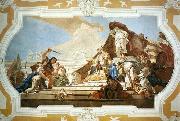
Oil On
Canvas, Real Flavor of Old Masters
|
Stefano Magnasco
|
|||
|
|
|||
| Italian, born circa Genoa 1635-1665 | |||
|
|
|||
|
|
The judgment of solomon new3/Stefano Magnasco-254258.jpg Painting ID:: 27386 Visit European Gallery |
mk56 oi lon canvas | |
Height Width |
INS/CM |
||
|
X |
|
||
|
|
|||
|
RAFFAELLO Sanzio
|
|||
|
|
|||
| Italian High Renaissance Painter, 1483-1520 Italian painter and architect. As a member of Perugino's workshop, he established his mastery by 17 and began receiving important commissions. In 1504 he moved to Florence, where he executed many of his famous Madonnas; his unity of composition and suppression of inessentials is evident in The Madonna of the Goldfinch (c. 1506). Though influenced by Leonardo da Vinci's chiaroscuro and sfumato, his figure types were his own creation, with round, gentle faces that reveal human sentiments raised to a sublime serenity. In 1508 he was summoned to Rome to decorate a suite of papal chambers in the Vatican. The frescoes in the Stanza della Segnatura are probably his greatest work; the most famous, The School of Athens (1510 C 11), is a complex and magnificently ordered allegory of secular knowledge showing Greek philosophers in an architectural setting. The Madonnas he painted in Rome show him turning away from his earlier work's serenity to emphasize movement and grandeur, partly under Michelangelo's High Renaissance influence. The Sistine Madonna (1513) shows the richness of colour and new boldness of compositional invention typical of his Roman period. He became the most important portraitist in Rome, designed 10 large tapestries to hang in the Sistine Chapel, designed a church and a chapel, assumed the direction of work on St. Peter's Basilica at the death of Donato Bramante, | |||
|
|
|||
|
|
The Judgment of Solomon new18/RAFFAELLO Sanzio-379493.jpg Painting ID:: 51248 Visit European Gallery |
1518-19 Fresco Loggia on the second floor | |
Height Width |
INS/CM |
||
|
X |
|
||
|
|
|||
|
TIEPOLO, Giovanni Domenico
|
|||
|
|
|||
| Italian painter, Venetian school (b. 1727, Venezia, d. 1804, Venezia). Italian painter and printmaker. He was apprenticed to his father, Giovanni Battista Tiepolo, in Venice in the early 1740s and worked with him in Madrid from 1762 until the elder's death in 1770. His most notable early works are the chinoiserie decorations of the Villa Valmarana in Vicenza (1757). Back in Venice, he executed several frescoes and paintings of scenes from the commedia dell'arte. A talented genre painter and caricaturist, he was famous for his many engravings and etchings after his own and his father's designs. | |||
|
|
|||
|
|
The Judgment of Solomon new19/TIEPOLO, Giovanni Domenico-578546.jpg Painting ID:: 51973 Visit European Gallery |
1726-29 Fresco 360 x 655 cm | |
Height Width |
INS/CM |
||
|
X |
|
||
|
|
|||
|
RAFFAELLO Sanzio
|
|||
|
|
|||
| Italian High Renaissance Painter, 1483-1520 Italian painter and architect. As a member of Perugino's workshop, he established his mastery by 17 and began receiving important commissions. In 1504 he moved to Florence, where he executed many of his famous Madonnas; his unity of composition and suppression of inessentials is evident in The Madonna of the Goldfinch (c. 1506). Though influenced by Leonardo da Vinci's chiaroscuro and sfumato, his figure types were his own creation, with round, gentle faces that reveal human sentiments raised to a sublime serenity. In 1508 he was summoned to Rome to decorate a suite of papal chambers in the Vatican. The frescoes in the Stanza della Segnatura are probably his greatest work; the most famous, The School of Athens (1510 C 11), is a complex and magnificently ordered allegory of secular knowledge showing Greek philosophers in an architectural setting. The Madonnas he painted in Rome show him turning away from his earlier work's serenity to emphasize movement and grandeur, partly under Michelangelo's High Renaissance influence. The Sistine Madonna (1513) shows the richness of colour and new boldness of compositional invention typical of his Roman period. He became the most important portraitist in Rome, designed 10 large tapestries to hang in the Sistine Chapel, designed a church and a chapel, assumed the direction of work on St. Peter's Basilica at the death of Donato Bramante, | |||
|
|
|||
|
|
The Judgment of Solomon new21/RAFFAELLO Sanzio-426954.jpg Painting ID:: 63803 Visit European Gallery |
1510-11 Fresco, 120 x 105 cm Stanza della Segnatura, Palazzi Pontifici, Vatican The story from the Old Testament tells how two women came to Solomon to settle a dispute about which one was the mother of a child. When Solomon ordered the baby to be cut in half, one of the women agreed to give up the child. Solomon recognized her as the true mother. The man holding the sword derives from a classical figure, either Castor or Pollux from the Quirinal, an ancient Roman palace.Artist:RAFFAELLO Sanzio Title: The Judgment of Solomon (ceiling panel) Painted in 1501-1550 , Italian - - painting : religious | |
Height Width |
INS/CM |
||
|
X |
|
||
|
|
|||










